|
Monday, February 14, 2011
Progress Notes
A few weeks ago I featured the biography of my recently deceased uncle, David Bear, who was born and raised in Miller County and after serving in WWII in Italy, spent the rest of his life in Alton, Illinois as a university professor.
In that narrative I copied David’s own story of his memories of that experience. I remarked then that I at a later date was going to present another Miller County Soldier’s experiences during war time which I thought was heroic and should be brought to the attention of our readers. His name was Colonel Curtis Fred Livingston who originally was from Iberia (photo 01).
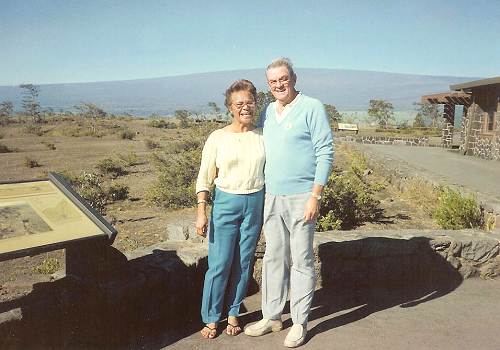
01 Curt and Lania Livingston Fred passed away in 2003. His obituary is quite detailed listing an extraordinary number of achievements and awards, many for his bravery and courage during battle. The obituary as well as his own personal story of being a captive during WWII were given me by former Iberia resident, Carolyn Burks Levell who now lives in Springfield, Mo.
Here is Colonel Livingston’s obituary:
Colonel (Retired) Curtis Fred Livingston passed away Tuesday, March 4, 2003, at home. He is survived by his wife, Rose, his two sons, Major (Ret) Stephen C. And Darryl J. Livingston, his stepson Aaron Costa, and stepdaughters Debbie Neves, Rowens Freeman, and Patricia and Dorena Costa.
Born September 14, 1920 to Samuel and Etta Livingston in Iberia, Missouri, he was the youngest of 10 siblings. He enlisted in the Army August 15, 1939 as an infantryman, and served with the 1st Battalion 15th Infantry under Dwight D. Eisenhower, who was his battalion commander. Colonel Livingston attended Officer Candidate School in 1941, and was commissioned as an Infantry officer. He was assigned to the 143rd Infantry Regiment of the 36th Infantry Division (Texas), where he participated in the African Campaign. He participated in the landings at Salerno, Italy on 9 September 1943, and was a boat commander in the second wave. His regiment encountered fierce German resistance, and suffered extremely heavy casualties. Then Lt. Livingston was captured inland from the beachhead by the Germans on his 23rd birthday, 14 September 1943. He was held in captivity at the German prison camp Oflag 64 in Szubin, Poland. In January 1945 the Germans evacuated the prison camp in Szubin and began the prisoners on a 300 mile trek in temperatures that exceeded 40 degrees below zero. Livingston was part of a group of POWs from that camp that were suffering from severe frostbite and chilblains. He was ordered to return to the camp where he was liberated by the Russian Army in late January 1945. After World War II he served in both infantry and military intelligence assignments. He served as the AC of S G2 1st Armored Division during the Cuban Missile Crisis in October 1962. The 1st Armored Division was deployed and prepared to invade Cuba had the Russians not dismantled the missiles. He subsequently served as the Commander, 5th Battalion (M) 6th Infantry, 1st Armored Division at Fort Hood, Texas. He is also a veteran of the Viet Nam conflict, having served as the G2 for I Field Forces Vietnam from 1970 to 1971. He continued to serve his country as a professional Army officer until his retirement in 1974. His awards include the Combat Infantryman’s Badge, 2 awards of the Legion of Merit, the Bronze Star with “V” device for valor, the Meritorious Service Medal, the Army Commendation Medal, the Vietnamese Cross of Gallantry with Gold Palm (individual award), the Vietnamese Medal of Honor 1st Degree, Prisoner of War Medal, World War II Victory Medal, American Defense Medal, American Campaign Medal, European African Middle East Campaign Medal, the National Defense Ribbon with two oak leaf clusters, the Vietnamese Service Medal, the Republic of Vietnam Campaign Medal, and Vietnamese Cross of Gallantry with Palm (unit award).
Colonel Livingston will be cremated and no services are planned. Those who wish to honor him may do so by contributing to the Waiakea Chapter of the Young Men’s Christian Association, where he served as a member and as President of the Hawaiian Chapter. He often commented that he “owed” the YMCA for his being able to survive his captivity in prison camp in World War II.
The following narrative was written by Colonel Livingston detailing his experiences as a German prisoner of war during WWII (photos 02 - 07 – PDF Doc).
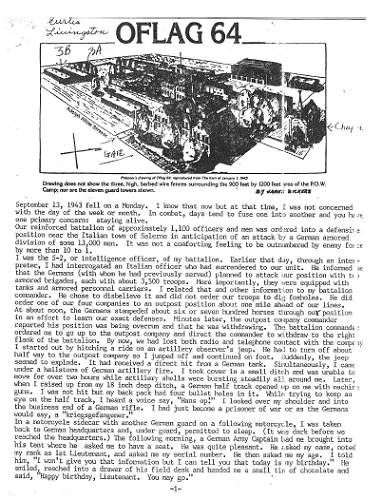
02 Curtis Fred Livingston WWII Experiences
Click image to read entire document in PDF formatHere is a sketch of the prisoner’s camp where Colonel Livingston spent some of his time in captivity (photo 08):
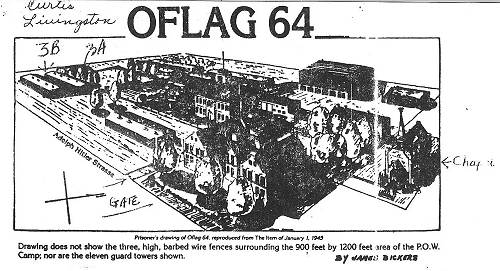
08 Oflag 64 Prison Camp
Click image for larger viewI am thankful that we have had men of the character and ability of Colonel Livingston throughout our history who have stepped up to defend our country in time of need.
A few years ago Peggy Hake (photo 09), our most prolific historical author, wrote an article for the Autogram Sentinel in which she told the story of a cholera epidemic in Cole County which caused a migration of some residents from there to Miller County.
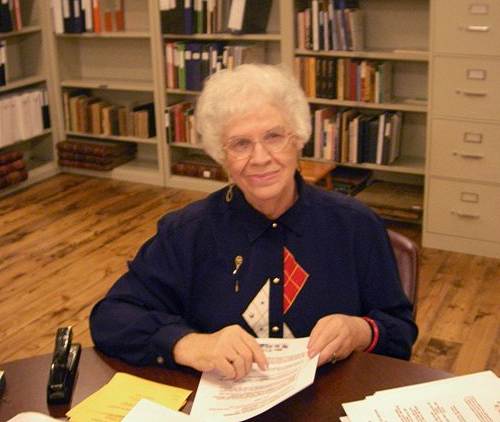
09 Peggy Hake This article is on our website in abbreviated form; however, I thought it was an interesting story so I am putting the entire article on the website this week.
Cholera In Central Missouri
Peggy Hake
While reading an old 1932 Miller County Autogram, I found an article which told a story of the devastating cholera plague that hit Central Missouri in 1832. An elderly man living near Tuscumbia, John Pickering, told the story of his grandmother’s family and their struggle to escape the dreaded disease.
John was descended from a French family who settled in Cote Sans Dessein (photo 10), a French settlement north of the Missouri River in Callaway County, later destroyed in raging flood waters of the Missouri.
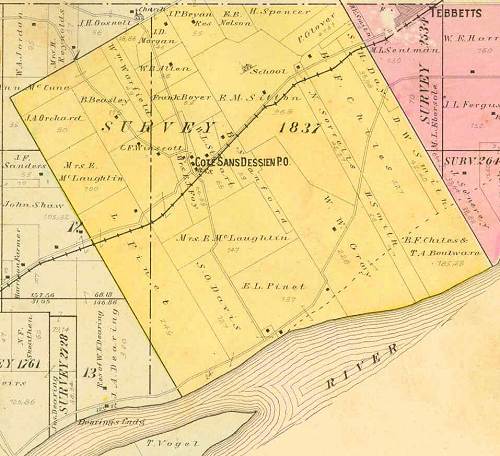
10 Cote Sans Dessein
Click image for larger viewThe settlement was begun in the early 19th century and in later years was known as Barkersville. In 1812, the small settlement was attacked by Indians and the siege was held off by three men and two women including Baptiste Louis Roi.
Note: The story of Cote Sans Dessein is interesting. I copied it here from the Callaway County website (photo 11):
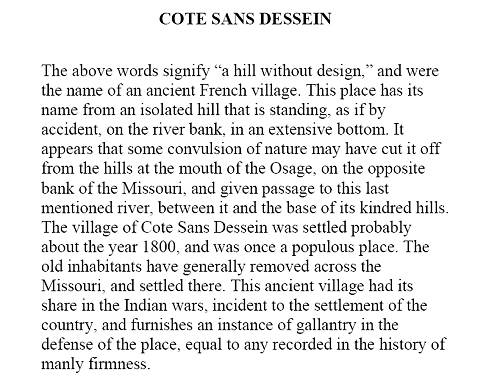
11 Cote Sans Dessein
Click image to read entire document in PDF formatAs time passed, these early settlers paddled their canoes up the Osage River in search of wild game which was more plentiful in the Osage country.
One of the hunters was Baptiste Denoya, the great grandfather of John Pickering. Legends were told of these hunters…Baptiste Denoya was an old time fiddler and the others would dance to his lively music. In those days it was said that every family had a jug of brandy. With the brandy, the fiddle music, and dancing, those early settlers livened up their hunts which lasted for days.
In 1832 there came a time of distress and disaster at Cote Sans Dessein when cholera broke out in Callaway County. Baptiste Denoya, his family and friends, fled from the settlement to escape the epidemic. They came up the Osage in their canoes, navigating about 50 miles upriver and stopped at the mouth of Bois Brule Creek in Cole County.
It’s headwaters begin near the Miller/Cole County line on Highway 54 and it flows eastward where it empties into the Osage about three miles west of present day St. Thomas.
Here is a short history of the Bois Brule Creek (photo 15):
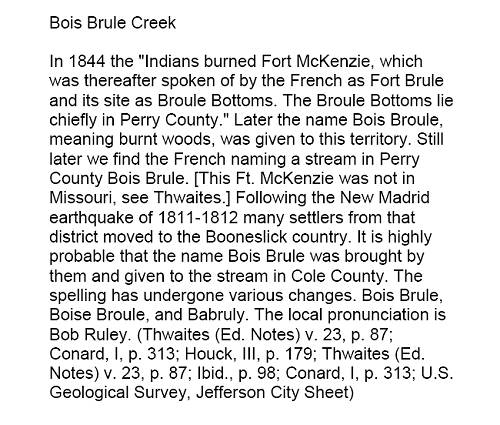
15 Bois Brule Creek
Click image to read document in PDF formatMargaret Denoya, the grandmother of John Pickering, later married a Roi (probably from the family of Baptiste Louis Roi). She was born in July 1816 and was 16 years old when her family landed at Bois Bruhle. She had a young brother who died there and was buried in a common grave near the creek. She told how her brother was buried…they hewed out a log and placed the child’s body, wrapped in a blanket, inside the log. A second hewn log was placed on top of the body and then covered with earth. You certainly have to admire those early pioneers who braved the wilderness and blazed the trail for those who later came to make their homes in the valleys of the Osage.
Margaret Denoya Roi and her husband had only one child, a daughter, who married Augustus Pickering. I do not know when this family came to Miller County. They do not appear in any census record of the county until 1900. At that time, Margaret Roi (Roy) was living with her son in law, Augustus Pickering, in Osage Township near the families of Nixdorf, Burks, Pierce and Colvin. A daughter (name unknown) had died by this time and all that was left of her family was her son in law, Augustus and her grandson and wife, John and Pauline Pickering. They all lived near each other in Osage Township.
Margaret died in October 1904 and was buried at Old Mt. Zion Cemetery, a few miles south of Tuscumbia. Augustus Pickering, his son John and daughter in law Pauline, are also buried there near Margaret. Evidently this family of Denoya/Roi/Pickering left no descendants.
Margaret Denoya Roi/Roy lived out her elderly years with and near her grandson, John Pickering, and I would wager she had a marvelous memory. I am sure John heard the story many times of the family’s flight in 1832 to avoid the great cholera plague which enabled him to give the Autogram a marvelous story!
Today is Valentine’s Day! For the occasion I am copying here an old article found in the Autogram which was published in 1916 about the subject of “kissing” (photo 16)!

16 Kissing Miller County Autogram Sentinel
February 1916
The Open Air Kiss Safest
Copied From the Boston Post
A kiss in the open air is fraught with less danger and fully as much pleasure as a kiss indoors.
These grip germs that have been laying siege to Boston and other important American cities are unable to make any flank attacks when a kiss is bestowed in the open air, but when the labial salutation is given in a closed room, the microbes are likely to make a mass attack and get at least one victim and possibly two. All this according to more or less wise Harvard students.
By the same token, kissing in sun light is better than kissing in moonlight, for the sun has a knack of dispersing grip germs that the moon has thus far failed to acquire. Therefore, the most healthful kiss of all is the one that is given in the open air during the daytime, although it isn’t being done very much this season. But if it has to be done at night, it is better for a swain to snatch a kiss on the veranda than in the parlor.
The cheek has the highest rating among the areas within which a kiss may be properly bestowed. The forehead is the second best and the lips take third money. Germs lurk in the least numbers on the cheek.
Kissing should not be done while the kisser is wearing a veil. Science has released the information that germs cling to the silken texture of a veil and these are likely to be readily transferred. Besides, a young woman is likely to strain her voice if she talks while wearing a veil.
The difference between a regular kiss and a soul kiss is two minutes and upwards, the same Harvard authorities assert.
At the time this article was written the germ theory was well known and taught. However, what to do about disease germs was less known. Antibiotics didn’t appear until the late 1930’s when Penicillin was extracted from mold and found to have antibiotic characteristics. So the only way to be safe regarding germ caused diseases was to be extra careful about exposure to them. That seems to have been the thrust of this article. However, some of the advice seems really to stretch reality, especially the warning not to kiss at night!
Another article written by Peggy Hake that I have on hand this week presented Miller County history as a series of “factoids of firsts:”
HISTORICAL FACTS OF MILLER COUNTY
BY PEGGY SMITH HAKE
1837 -- The first post office in the county was established at Tuscumbia on December 21, 1837 -- James Pryor Harrison was the first postmaster. Mail was delivered horseback once a week from Waynesville to Jefferson City via Tuscumbia.
1837 -- A merchant’s license was issued to William H. Pulliam on November 6, 1837. He had a general store near present-day Iberia.
NOTE: The first store established in Miller County was located near Mt. Pleasant. Andrew Burris was the storekeeper and at that time it was in Cole County.
1837 -- The first marriage license was issued to Sims Brockman and Rachel Gartin, the marriage performed on February 26, 1837 by Andrew Kingery, a Baptist minister.
1839 -- The first courthouse was built and the first jail was
built about the same time. Both were made of logs (photos 17 and 18).
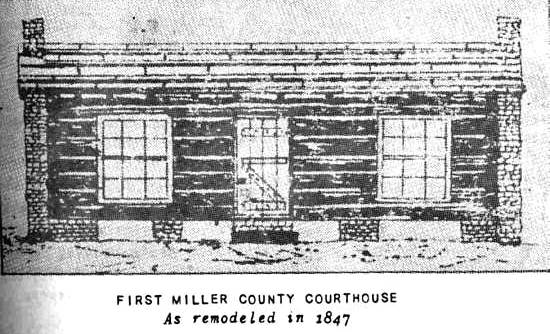
17 First Miller County Courthouse - 1830 - Remodeled 1847
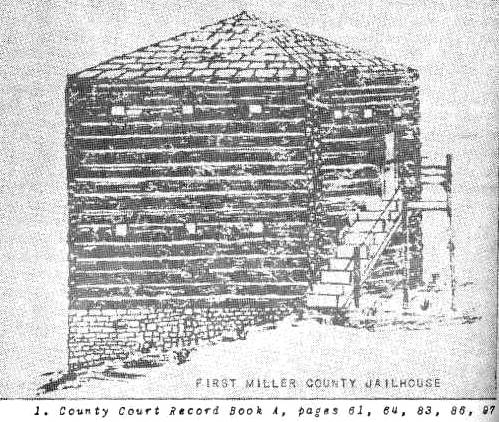
18 First Miller County Jail The second courthouse was built in 1858-59, a two-story brick building with a gabled roof. It had a courtroom on the first floor with offices in the front and above (photo 19).
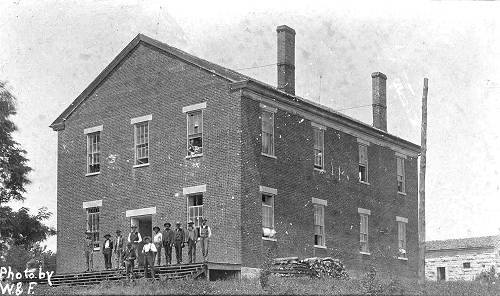
19 Second Courthouse - 1858
Click image for larger viewIn 1865, a stone jail was built in the courtyard.
The revision of the second courthouse began in 1910 and was finished a year or so later. This old courthouse is still standing but privately owned (photo 19b).
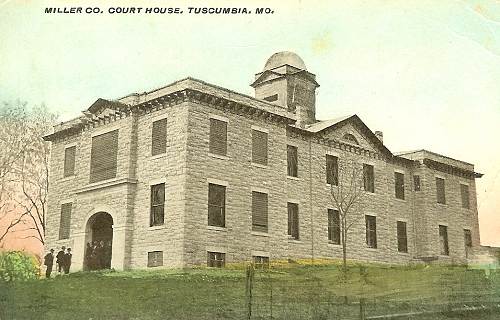
19b Miller County Courthouse - 1910
Click image for larger viewThe third courthouse, the present structure in use, was built in the early 21st century and sits facing Highway 52 “on top of the hill” toward Eldon (photo 20).
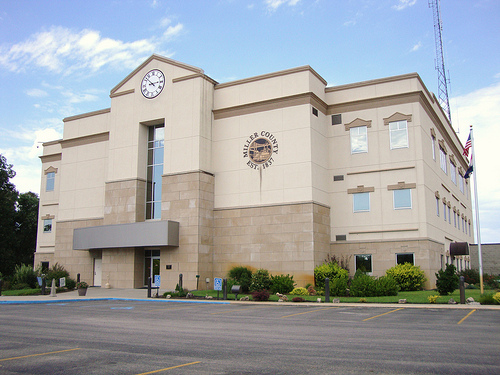
20 New Courthouse - 2004 1840 -- The Miller County Court established 14 school districts in the county.
Also, the first paupers (indigent) were farmed out by the county court.
1850 -- In 1850, Miller County had four post offices: Iberia, Tuscumbia, Pleasant Mount and Rocky Mount. By 1860, the post offices were located at Iberia, Tuscumbia, Ulman’s Ridge, Pleasant Farm, Mt. Pleasant, Rocky Mount, and Fairplay (on the Osage River).
1855 -- The first river improvement was voted on.
1860 -- According to the census of Miller County in 1860,
there were three Baptists churches, two Christian (Campbellites), two Methodists, and one Union church in the county.
1870s -- Horse racing, embezzlements, abortion, burglary, and a few other cases came up in the courts and by the 1880s, almost every variety of case known to ordinary circuit courts had appeared in Miller County.
SOME FIRSTS IN THE
COUNTY……….
First Divorce Case…(1838) — Lucinda Anderson vs. James Anderson (they had married in 1840 in Osage Township, marriage performed by Robert Boyd, J.P.)
Her maiden name was Burns — No record of them after they
married in 1840 (A BIG MYSTERY — How could she divorce him in 1838 when they married in 1840 ? ? ? ? )
First mortgage foreclosure was against Samuel L. Cole in 1839.
First naturalization of an immigrant was in 1840…Emmanuel Godlove, a native of Bavaria, Germany
First liquor law violation in 1845 was against Calvin and
Owen Riggs (Calvin Riggs was instrumental in forming the first Catholic settlement in the county at Old St. Elizabeth on the Osage River).
First case of ‘killing hogs’ in 1848, filed against John and Noah Hudson.
First “betting on elections” in 1853, against William N. Harrison (he was the county’s first sheriff).
And even another article by Peggy I have on hand this week is a chronological history of Miller County:
BY PEGGY SMITH HAKE
MILLER COUNTY’S
CHRONOLOGICAL HISTORY
1541 -- The Spanish explorer, Desoto, was the first white of record to come into what is Missouri and explored the Mississippi River area.
1673 -- The first white men to see the Missouri River area were Marquette and Joliet, French explorers.
1682–1805 -- During this period of time most of Missouri was owned by France and Spain.
1805 -- Missouri was part of the Louisiana Purchase when the U.S. bought that vast region.
1812 -- Missouri became a Territory with a population of 20,000. The southeastern portion of the Missouri Territory was admitted to the Union as the State of Missouri on August 10, 1821.
1821 -- Missouri was instituted as the 24th state with a population of 56,000.
1810–1850 -- Early settlers came to Missouri from Virginia, Kentucky, North and South Carolina, Tennessee, Pennsylvania, Maryland and other eastern states.
1837 -- Miller County was formed on February 6 from Cole and Pulaski counties (photo 28).
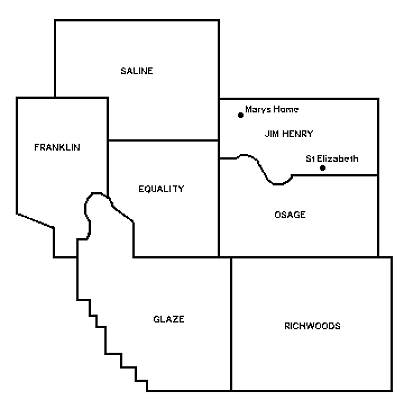
28 Miller County SOME EARLY SETTLERS IN MILLER COUNTY . . .
1719 -- The first known white man in present day Miller County was a French explorer named Charles Claude DuTisne. He explored the Osage River region and traded with the Osage Indians.
1806 -- Zebulon Pike, the early explorer, came through Miller County in 1806 on his expedition to present-day Colorado. He traveled the Osage River on his way west.
1807–1822 -- Other early settlers included William West in
the Tavern creek area, northeast of St. Elizabeth in 1807; Seneca Day, 1815, settled north of St. Elizabeth on the Tavern Creek; A.J. Lindley 1819, also in the same
area of the Tavern; John Wilson 1822, settled in Osage Township near the Barren Fork and Tavern Creeks and he lived in a cave for awhile (photo 31).
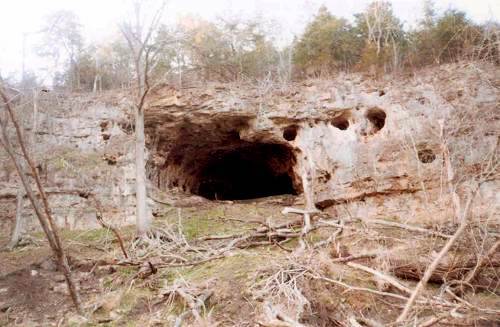
31 Wilson Cave HISTORICAL FACTS OF MILLER COUNTY .....
1821 -- Jan. 15, 1821, the first circuit court was held in Cole County which later became and included the northern section of Miller County.
1826 -- The first man to enter land in what is today Miller County was William Miller. He settled near Spring Garden on July 20, 1826 (photo 32).
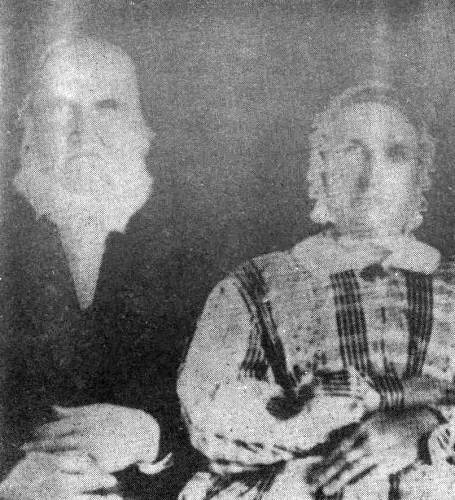
32 William and Sarah Miller 1834 -- The first water mill was built in Miller County by William Brockman on the Saline Creek and a few years later William Williams built the second mill.
The first steam mill was built in 1853 by John Humes near Mount Pleasant (photo 34).
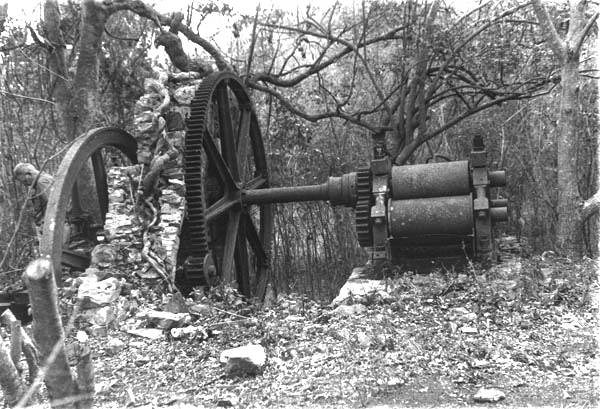
34 Replica of early style Steam Engine 1836 -- In February 1836, James Pryor Harrison entered land where the town of Tuscumbia now stands. James and his brother, John Brazil Harrison, donated land so Tuscumbia could be established as the new county seat.
That’s all for this week.
 Joe Pryor
Previous article links are in a dropdown menu at the top of all of the pages.
|

